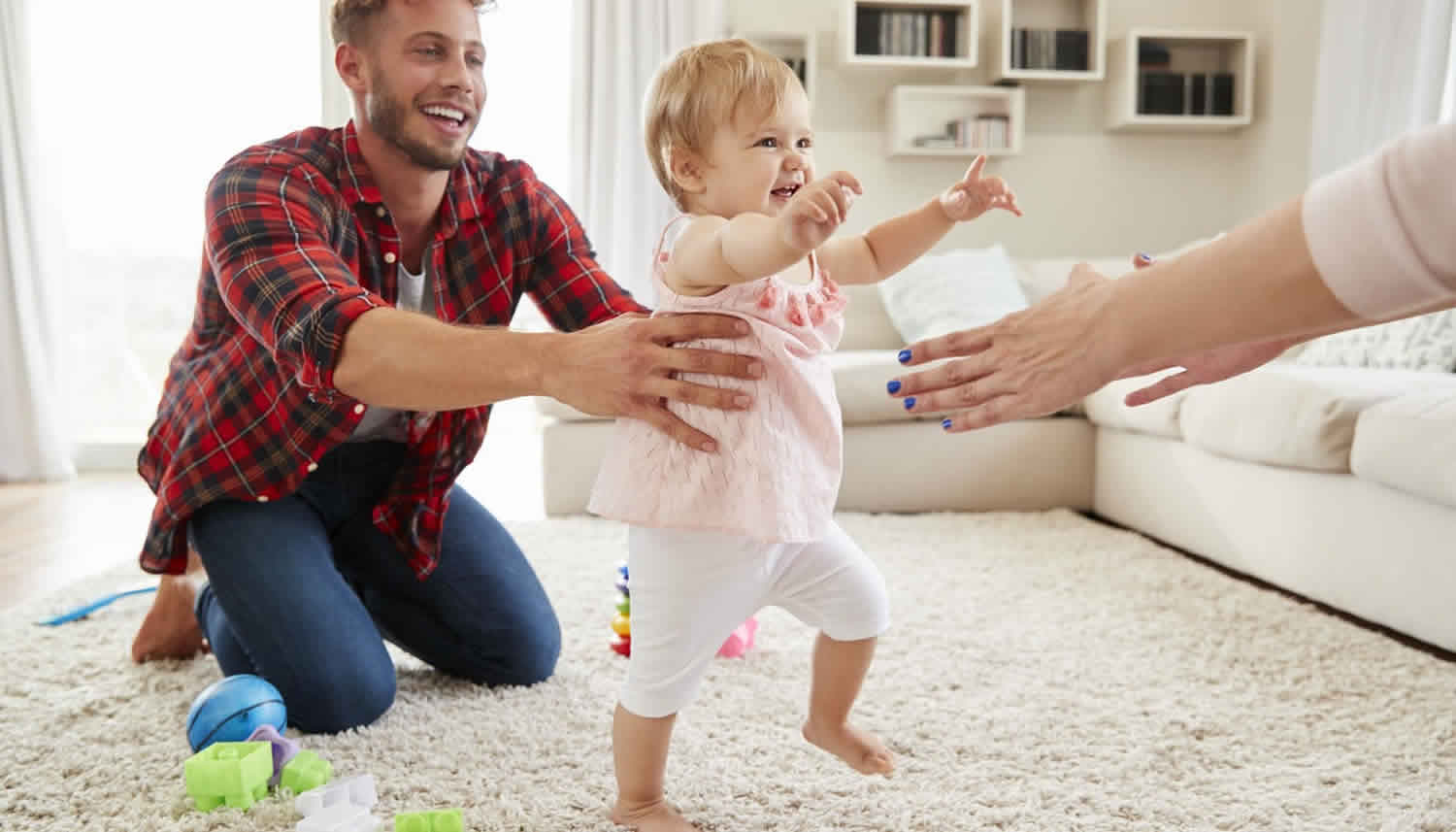Contents
When do babies start standing
Before your baby can stand he/she will need to gain muscle strength and coordination, which will also help him/her learn to roll over and sit on his/her own.
At around six months your baby will be able to sit with some support from you and by seven or eight months he should be able to sit comfortably on his own. At around the same time you should be able to help him to stand up by gently pulling him up and then giving him support.
Between seven months and a year your baby should move on to pulling himself up. He may only be able to stand for a few moments before he falls backwards with a gentle bump. Keep an eye on your baby at this stage. He’s unlikely to hurt himself falling backwards in a cleared space but it may give him a fright. You can help make your baby safer by clearing the space around him of toys and sharp objects, and laying a few cushions on the floor in case of a fall. Be ready to give lots of cuddles, kisses and reassurance.
Learning how to fall is an important part of mastering standing and walking. You can see this process starting at around six months. When you’re supporting your baby in a standing position, he’ll put his arms out to save himself if he tilts off balance. A month later he will have learned to put his arms and hands out to help him gently fall to the ground on his front.
At nine months your baby may find pulling himself up to stand is becoming easier. However, he may still be unable to lower himself, instead falling backwards with a gentle bump.
When your baby pulls himself up on the furniture he’ll stand on his toes first. With some practice he’ll eventually stand flat on his feet, which makes him more stable.
Learning to stand will soon become second nature. With something to hold on to, your baby will soon pull himself up with ease.
Around his first birthday, confidence and balance will help your baby to achieve his ultimate goal of standing alone without any help from furniture or people. He may even begin to work out how to bend his knees and learn to sit down after he’s been standing.
What to expect with your babies
At 3-6 months, your baby might:
- reach for toys and roll on to her back during tummy time
- bring her hands to her mouth and reach for her legs and toys when lying on her back
- try rolling from tummy to back and back to tummy.
By 6-9 months, many babies like lying on their tummies rather than on their backs. When babies lie on their tummies, they can reach for toys and move around in a circle. When they’re ready, they might even try to crawl. Other things your baby might do at this age are:
- roll from tummy to back and back to tummy
- sit with your help or by himself
- push up onto his hands and knees
- stand on his legs with your support.
From 9-12 months, your baby might:
- crawl, roll and pull to stand
- sit by herself and reach for toys without falling
- move from a sitting position onto her tummy and back again
- play using both hands.
Promoting your baby’s development
For babies of any age, learning and play are inseparable. To support your budding adventurer:
- Create an exploration-safe environment. Keep only safe objects within your baby’s reach. Move anything that could be poisonous, pose a choking hazard or break into small pieces. Cover electrical outlets, use stairway gates, place cords from blinds or shades out of reach, and install child locks on doors and cabinets. If you have furniture with sharp edges, remove it from rooms where your baby plays. The same goes for lightweight objects your baby can use to pull himself or herself to a standing position, such as plant stands, decorative tables, potted trees and floor lamps. Anchor bookcases, televisions and their stands to the wall.
- Keep chatting. You’ve likely been talking to your baby all along. Keep it up! Narrate what you’re doing, and give your baby time to respond. Say something to your baby and then wait for him or her to repeat the sounds. Sing simple songs. Ask your baby questions that involve more than a yes or no response. You might not be able to pick words from your baby’s babble, but you can encourage a back-and-forth conversation.
- Teach cause and effect. Push the button on a musical toy and dance to the tune. Open the door on a toy barn and listen to the cow say “moo.” Help your baby do the same. Self-confidence will grow as your baby realizes he or she can make things happen.
- Take time to play. By now, you and your baby might be old pros at classics, such as peekaboo, patty-cake and itsy-bitsy spider. Get creative. Arrange cushions and pillows on a carpeted floor and encourage your baby to creep or crawl over them. Stack blocks and invite your baby to knock them down. If you’re up for a mess, smear applesauce on the highchair tray and let your baby “paint” with the mixture. At bath time, provide small containers and plastic utensils for pouring and mixing.
- Pull out the books. Set aside time for reading every day — even if it’s only a few minutes. Reading aloud is one of the simplest ways to boost your baby’s language development. Make it more interesting with facial expressions, sound effects and voices for various characters. Store books within easy reach so that your baby can explore them whenever the mood strikes.
Consult your baby’s doctor if you’re concerned about your baby’s development or your baby:
- Doesn’t roll over in either direction or sit with help
- Doesn’t bear some weight on legs
- Doesn’t try to attract attention through actions
- Doesn’t babble
- Shows no interest in games of peekaboo
Also contact your child’s doctor if:
- You notice that your child is using only one side of her body to crawl (she pushes off with only one arm or drags one side of her body as she scoots across the floor); or
- Your baby is not making forward progress in using her body to get around.
Trust your instincts. The earlier a problem is detected, the earlier it can be treated. Then you can set your sights on the milestones that lie ahead.
My baby is almost 12 months old and isn’t standing yet. Should I be worried?
If your baby isn’t able to put weight on his legs and stand by the time he’s a year old, or you’re worried about how he’s developing, talk to your doctor. Babies develop skills differently, some more quickly than others. Usually there’s nothing to worry about.
If your baby was born early (before 37 weeks of pregnancy), keep in mind that he may reach this and other milestones a little later than other babies.
How can I encourage my baby to stand?
Your baby needs to get the hang of standing and pulling himself up from sitting. You can help by giving him lots of practice at standing – on your knees when you’re sitting down or leaning against the cushions at the back of the sofa. If you put toys just out of reach on the sofa when your baby is on the floor, this will encourage him to pull himself up to get them.
Here’s how you can give your baby some standing up practice:
- Kneel or sit on the floor in front of a sturdy coffee table or a low sofa. Put some favorite or interesting toys on the furniture.
- Sit your baby on your knee with his feet on the floor.
- Encourage him to reach forward and hold onto the furniture.
- Put your hands around his hips and help him to stand by moving his hips forwards as he straightens his legs.
Here are some other tips to help him get on his feet:
- Let your baby roll, crawl, bottom shuffle or cruise whenever you can. Exploring his environment will stimulate his natural curiosity, encouraging him to reach and grasp.
- Set up play dates with friends or relatives with children. Playing alongside babies of a similar age will encourage your baby to imitate his peers. Plus, it’s more fun!
Be your baby’s biggest fan
Lots of encouragement, clapping and smiling from you will give your baby the confidence he needs to try new things. As he learns to stand, he may need some help working out how to sit down again. If he gets stuck and cries in frustration, resist the urge to pick him up. Show him how to bend his knees and encourage him to try it for himself.
Once my baby can stand, what will he do next?
Once your baby has learned to stand he will do so for as long as he can. Upright, he will discover a whole new world to explore.
If he falls on a carpeted floor or a soft surface, this probably won’t hurt him. However he may still cry in frustration rather than in pain. The thrill of standing is gone and that’s what hurts!
As your baby gets better at standing, he’ll start to cruise (moving around upright while holding on to furniture). He may then feel confident enough to let go of any support and stand on his own or be able to take small steps when you hold his hands. Your baby may even bend down to pick up a toy when he’s standing.
Motor developmental milestones for children from baby to 5 years of age
Newborn
- Turns head easily from side to side. When lying on back, moves head one way and then another.
- Comforts self by bringing hands to face to suck on fingers or fist.
- Keeps hands mostly closed and fisted.
- Blinks at bright lights.
1 Month
- Raises head slightly off floor when lying on stomach.
- Holds head up momentarily when supported.
- Keeps hands in closed fists.
- Comforts self by sucking on fist or fingers.
2 Months
- Holds head up and begins to push up with arms when lying on stomach.
- Makes smoother movements with arms and legs.
- Moves both arms and both legs equally well.
- Brings hands to mouth.
3 Months
- Lifts head and chest when lying on stomach.
- Moves arms and legs easily and vigorously.
- Shows improved head control.
4 Months
- Holds head steady without support.
- Grabs and shakes toys, brings hands to mouth.
- Pushes down on legs when feet are placed on a hard surface.
- Pushes up to elbows when lying on stomach.
- Rocks from side to side and may roll over from tummy to back.
6 Months
- Rolls over in both directions.
- Begins to sit with a little help.
- Supports weight on both legs when standing, and might bounce.
- Rocks back and forth on hands and knees, may crawl backward before moving forward.
9 Months
- Gets in and out of sitting position, and sits well without support.
Creeps or crawls. - Pulls to stand and stands, holding on.
- Begins to take steps while holding on to furniture (cruising).
12 Months
- Pulls to stand and walks holding on to furniture.
- Gets into sitting position without help.
- Begins to stand alone.
- Begins to take steps alone.
18 Months
- Walks alone, and begins to run and walk up steps.
- Walks backward pulling toy.
- Feeds self with spoon and drinks with cup.
- Helps dress and undress self.
2 Years
- Kicks a ball forward.
- Throws a ball overhand.
- Walks up and down stairs holding on.
- Stands on tiptoes.
- Begins to run.
- Climbs on and off furniture without help.
- Puts simple puzzles together.
3 Years
- Climbs and runs well.
- Walks up and down stairs, with one foot on each step.
- Jumps with both feet, and may hop on one foot.
- Pedals tricycle or three-wheel bike.
4 Years
- Catches a bounced ball most of the time.
- Hops and stands on one foot for a few seconds.
- Pours beverages, cuts with supervision and mashes own food.
5 Years
- Hops and may be able to skip.
- Does somersaults.
- Uses a fork and spoon, and sometimes a table knife.
- Stands on one foot for at least 10 seconds.
- Uses the toilet independently.
- Swings and climbs.


